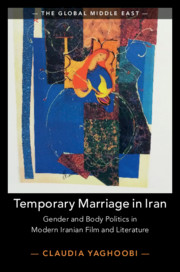Book contents
- Temporary Marriage in Iran
- The Global Middle East
- Temporary Marriage in Iran
- Copyright page
- Dedication
- Contents
- Acknowledgments
- Note on Transliteration, Dates, and Translation
- Prologue
- Part I General Overview
- Part II Representation of Sigheh/Sex Work in the Literature of the Pahlavi Era
- 2 Gendered Violence in Moshfeq-e Kazemi’s Tehran-e Makhuf
- 3 The Volatile Sigheh/Sex Workers’ Bodies in Jamalzadeh’s Ma’sumeh Shirazi
- 4 Colonized Bodies in Al-e Ahmad’s “Jashn-e Farkhondeh”
- 5 The Grotesque Sigheh/Sex Worker’s Body in Golestan’s “Safar-e ‘Esmat”
- 6 Bodily Inscriptions in Chubak’s Sang-e Sabur
- Part III The Islamic Republic and Sigheh in the Film Industry
- Bibliography
- Index
6 - Bodily Inscriptions in Chubak’s Sang-e Sabur
from Part II - Representation of Sigheh/Sex Work in the Literature of the Pahlavi Era
Published online by Cambridge University Press: 13 January 2020
- Temporary Marriage in Iran
- The Global Middle East
- Temporary Marriage in Iran
- Copyright page
- Dedication
- Contents
- Acknowledgments
- Note on Transliteration, Dates, and Translation
- Prologue
- Part I General Overview
- Part II Representation of Sigheh/Sex Work in the Literature of the Pahlavi Era
- 2 Gendered Violence in Moshfeq-e Kazemi’s Tehran-e Makhuf
- 3 The Volatile Sigheh/Sex Workers’ Bodies in Jamalzadeh’s Ma’sumeh Shirazi
- 4 Colonized Bodies in Al-e Ahmad’s “Jashn-e Farkhondeh”
- 5 The Grotesque Sigheh/Sex Worker’s Body in Golestan’s “Safar-e ‘Esmat”
- 6 Bodily Inscriptions in Chubak’s Sang-e Sabur
- Part III The Islamic Republic and Sigheh in the Film Industry
- Bibliography
- Index
Summary
Chapter 6 explores Sadeq Chubak’s Sang-e Sabur (The Patient Stone), which reflects the chaotic social conditions of the 1930s and includes a criticism of the institution of sigheh. Sang-e Sabur, too, explores the relationship between sigheh and the clerics, and how clerics exploit sigheh women as an income source. Chubak depicts the decadence of the social and religious systems of the country by hinting at the abundance of women contracting sigheh in pilgrimage zones to alleviate the conditions of their poverty. Chubak criticizes the way sex work is disguised under the façade of religion and sigheh. By exposing Gowhar to social violence and subsequent murder at the hands of a psychopath who has decided to purge society of sex workers, Chubak also indicts the social stigmatization and ostracization of sigheh women in Iranian society. This exposure to violence indicates that the patriarchal world in which Gowhar lives is hesitant to grant working-class women, especially sigheh women, the right to control their own sexuality and thus their subjectivity. Hence, Gowhar’s murder can be viewed not only as an act of gendered and sexual discrimination, but also a class-based one – and altogether a violation of her rights as a human.
Keywords
- Type
- Chapter
- Information
- Temporary Marriage in IranGender and Body Politics in Modern Iranian Film and Literature, pp. 175 - 200Publisher: Cambridge University PressPrint publication year: 2020



